
How to Treat Shoulder Injuries from Wing Chun Training
May 03, 2015
“Not a doctor…shhhh!”
Brooklyn Nine Nine credits
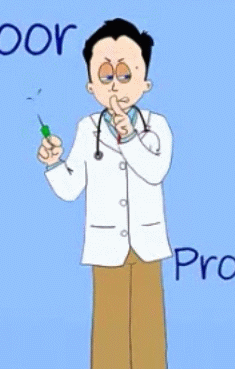
DISCLAIMER: I’m NOT a doctor, so the following is all intended for entertainment purposes only.
The shoulder muscles and tendons on humans are capable of generating and transmitting tremendous energies.
Human beings have pressed well over 400 pounds over their heads. Other people have thrown balls over 100 miles an hour. People have punched with a force in excess of 1000 pounds per square inch.
Yet this complex of muscles, bones, and tendons we call the shoulder is also potentially very delicate and difficult to repair when damaged.
A lot of us in Wing Chun get these injuries from training in partial ignorance. We do the Bong Sao slightly wrong or our partner hangs on it with their Fook Sao and next thing you know we start getting sore. Then we ignore it for months or years and develop a more chronic condition.
I’ve had all these issues and recently I developed problems of the chronic variety, I think because I switched jobs and the new position is more sedentary. Some days I sit nearly the whole day and nearly two years of this started to take its toll.
So I had to read a bunch of books, go to a masseuse and a doctor and a finally a physical therapist to determine first what the problem was and then to develop a treatment and rehab plan.
The rotator cuff is a group of muscles and tendons that act to stabilize the shoulder.
This idea of stabilization is very important. The four muscles of the rotator cuff are the supraspinatus, the infraspinatus, the teres minor, and the subscapularis.
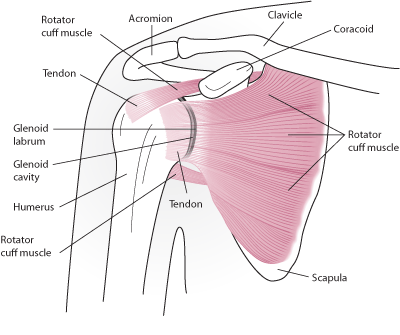
Your shoulder joint is also composed of three bones: the clavicle (collarbone), the scapula (shoulder blade), and the humerus (upper arm bone).
The best way to think about this area is that you have these three bones which are tied into a cup-like structure by the tendons. Its like the way the hands of two people intertwine to become a Fireman’s carry.
Your shoulders are the most movable joints in your body. They tend to be somewhat unstable because the ball of the upper humerus is larger than the shoulder “socket” (that cup of tendons) into which it inserts. It slips in and out of the socket.
To be stable, the humerus must be pulled into the socket by the muscles, tendons and ligaments. This stability requires good structural habits which are easy to neglect.
We form bad habits due to the demands of modern life, which push us toward doing a lot of “rounding” of our shoulders and backs.
Sitting at the computer in a shoulders-forward and round-backed manner will weaken the habit of having good posture and undermine the stability of your shoulder joint. Sitting a lot on soft couches will also encourage a rounded back and shoulders which sit forward of the collarbone. This creates a weak and structurally unsound capsule for the rotating motions of the humerus.
If you habitually (or even one wrong time) put a lot of structural pressure on this area when the humerus is not securely tucked into the “capsule” of the joint, you can strain or tear one or more of the tendons.
A good example of this would be doing a tight, tense Bong Sao which is raised instead of rotated out combined with a partner pulling that Bong down with a heavy Fook or explosively with a sudden Jutt Sao.
Other shoulder injuries and chronic problems go by various names: sprains, dislocations, separations, tendinitis, bursitis, frozen shoulder, fractures, and arthritis.
Usually shoulder problems are first treated with RICE (Rest, Ice, Compression and Elevation). If you get a sore shoulder, start there. Put an ice pack on for 15 minute stretches. Skip a few classes and don’t aggravate the injury with movements outside the average range of motion. Don’t raise your arms over your head.
If this doesn’t help in a week or two, or you find you are developing a more chronic condition are have a more severe injury, other treatments include exercise, medicines to reduce pain and swelling, and ultimately surgery if these other treatments don’t work.
If you are lucky enough not to have experienced any shoulder injuries yet, I recommend you begin an exercise routine to strengthen this area. This is one of those areas where trouble will come knocking as you age and your best defense is a “prophylactic” regimen of strengthening the area.
If you want to go hardcore (and are between 15 and 35), I would suggest a basic weight-lifting regimen of the sort advocated in Mark Rippetoe’s book Starting Strength . If you learn the correct form for these exercises and build a general muscularity, your shoulders will take care of themselves. Here is a good commentary on Rippetoe’s book to put it in a little perspective. The thing I like about his program is the attention to technique. You may want to go at it with less intensity than he advises.
I’m a big fan of using partial plates (smaller than 2 1/2 pounds) to make the increases in weight more gradual and to help avoid injury.
On the other end of the spectrum, I would advise most people (especially older or younger) to start carefully and follow the sort of regimen that is prescribed after an injury for rehab, a careful of regimen of gradual strength building beginning with exercise bands and later (if you are healthy) to do body weight stuff like push ups and free squats.
This approach follows the first rule of medicine, which is first do no harm . If you are just starting out training and feel pretty weak, or are already injured, do not try to “tough it out.” Build your capacity slowly.
If you go to a doctor and are diagnosed with some sort of muscle or tendon injury, first they will start you off on a regimen of something like Ibuprofen or Motrin ( NSAIDs or anti-inflammatory drugs ) for ten days. NOTE: These are not to be trifled with as they can have all sorts of nasty side effects like stomach bleeding and heart issues.
Advil and Aleve are commercial examples, which typically come in 200mg doses.
Then they may put you on the physical therapy regimen to build strength in that area and to pull your shoulders back.
I did some of these exercises before, but now I do all of them every day. My goal is to develop “bulletproof” muscles and tendons in my shoulder socket.
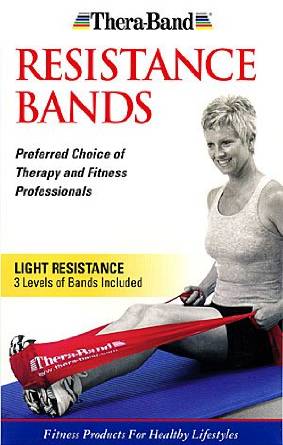 I injured the suprasinutus tendon and this is one of the most common shoulder injuries. If you have it, you may experience it as a pain in the outer head of your deltoid, either on the outside of the shoulder or deep “inside” the back of your shoulder above your scapula.
I injured the suprasinutus tendon and this is one of the most common shoulder injuries. If you have it, you may experience it as a pain in the outer head of your deltoid, either on the outside of the shoulder or deep “inside” the back of your shoulder above your scapula.
Get yourself some Thera-Bands or a similar product and start with the “lightest” tensile strength (with the Thera-bands, this is the yellow band). There are five strengths available.
Do each exercise for 10 reps once a day. If you start closer to the anchor point of the band, then over the course of a month, slowly move a little further away, adding more and more tension, this will add slowly to the resistance.
See how you feel. I was able to trade up easily to the next band strength (red) after month. If you’re injured, this exercises will make you sore for a little while (but it shouldn’t hurt all day, unless it already does). As above, check with your doctor or your PT if you are already injured.
I do the scapular retraction one frequently, whenever I think of it.
I do all of these every day except 112 and 113 and hopefully I will be back to regular training starting in June (I’m still teaching every day but I took a month off from Greg’s class).
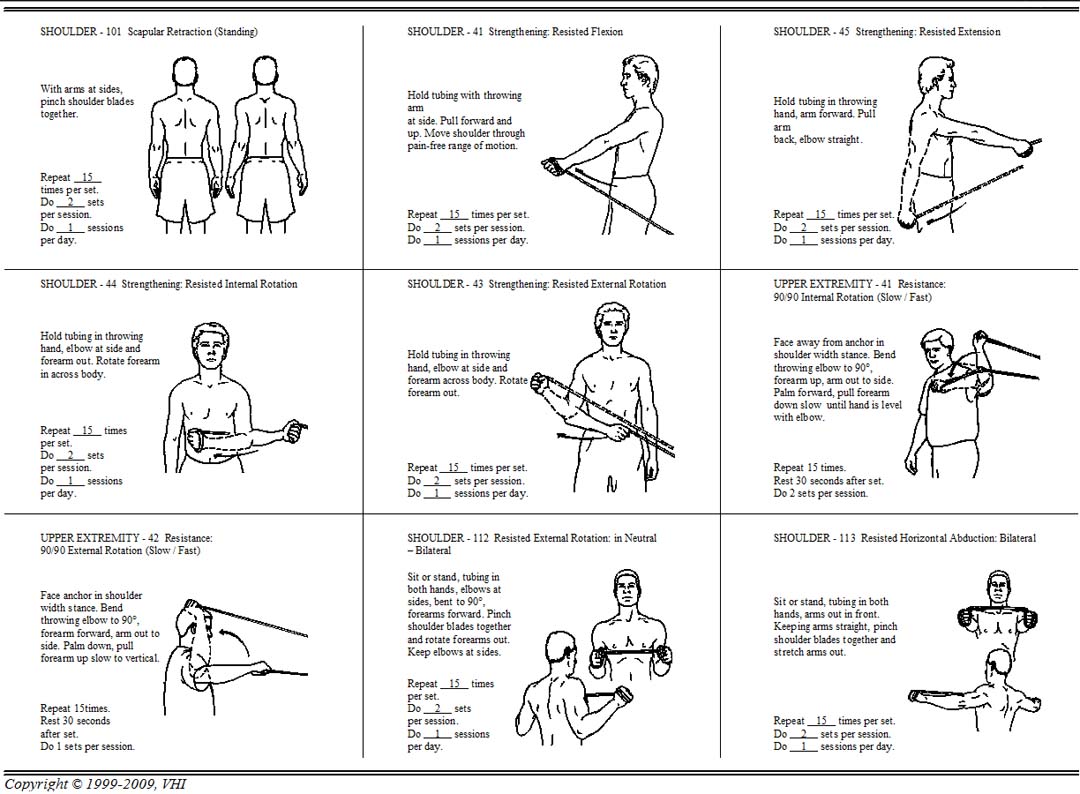
I got this off somebody’s Pinterest page – if it is yours, please let me know and I will link it to your page (or take it down).
UPDATE: 12/08/16
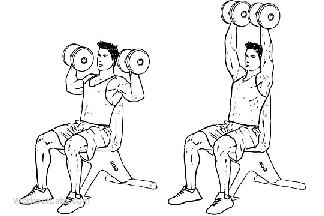 After going through many attempts to fix my shoulders, using RICE (Rest, Ice, Compression, and Elevation), heat pads, the bands, supplements, acupuncture, and weight-lifting, I believe the single most useful thing was the weight lifting.
After going through many attempts to fix my shoulders, using RICE (Rest, Ice, Compression, and Elevation), heat pads, the bands, supplements, acupuncture, and weight-lifting, I believe the single most useful thing was the weight lifting.
At first, I couldn’t even lift my arms over my head, so I did all of the above until I got to the point where I could do a sort of half-assed overhead press with a broom stick.
After a while, I switched to one pound dumbbells. Then five pound dumbbdells (doing dumbbell OH Press).
Then I just kept carefully adding weight and being very careful! 3 sets of 5. It took a long time – tendons build slowly, degenerate slowly, and heal slowly.